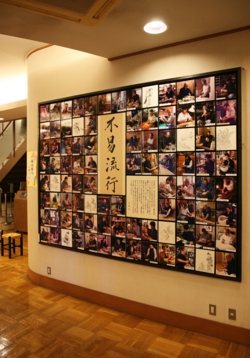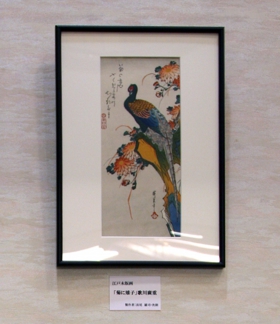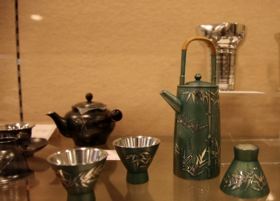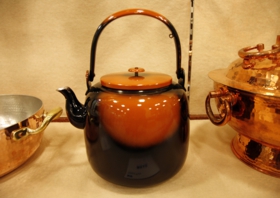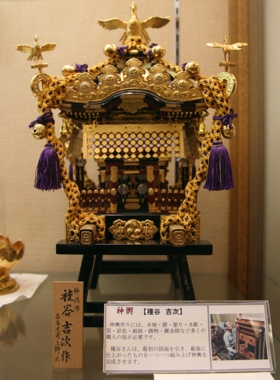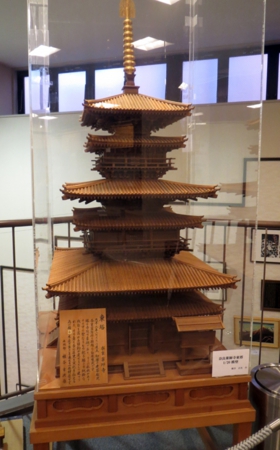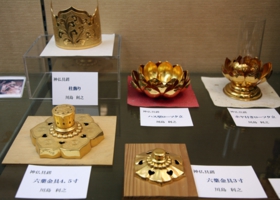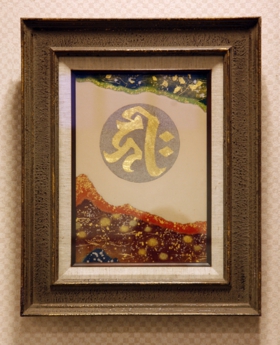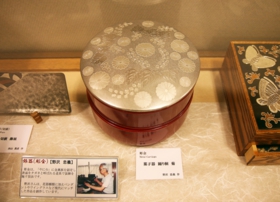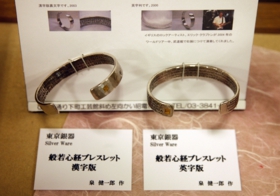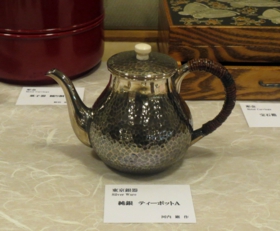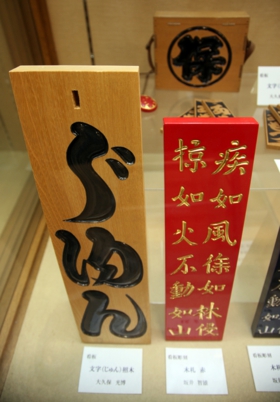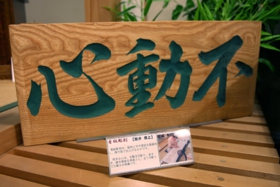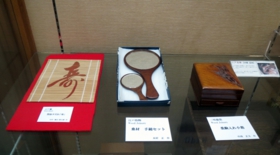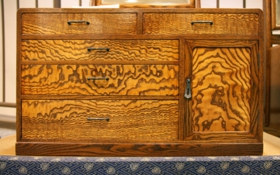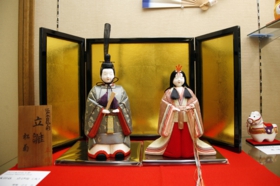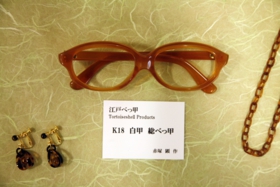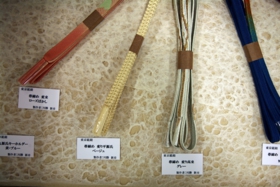About the exhibition room on the second floor
Yoshihiro Tanaka, a chairman of "Taito-ku Dentokogei Shinko-kai (traditional crafts promotion association)" in Taito City, guided us around the gallery.
An Edo-style wood block print by Yuji and Jiro Nagao
This wood block print was carved by Jiro, a younger brother, and printed by Yuji, an elder brother. Their sister has also carved wood block prints.
Tinware by Kei-ichi Nakamura
This is tinware. The melting point of tin is low. So it is relatively soft. If you drop tinware on the floor. it gets dented. This tinware was not beaten out, but cut out. Tinware is much in demand in the Nagoya region, while there is much demand for silverware in Tokyo.
Compared to silver, the price of tin is not so high. One of advantages of tin is that it keeps beverages cold or hot for fairly long hours. People tend to compare metal products, such as gold plate and silverware, based on their weight other than workmanship, but in nature the most difficult things are to carve patterns on the surface of metals and make them thin.
Copperware by Tamotsu Hoshino
Copperware by Tamotsu Hoshino
This copperware was made by beating out copper. Copper has high sterilizing power and good thermal conductivity. Also, the price is not so high.
A wood work (Portable Shrine) by Kichiji Taneya
A wood work (Miniature of Toji of Yakushi-ji Temple, Nara) by Kichiji Taneya
These are wood works. Taneya has mainly created portable shrines. This is a miniature of the east pagoda of Yakushiji Temple in Nara Prefecture.
Votive objects by Toshiyuki Kawashima
These are ornamental metals. In addition to ornamental metals for furniture, many ornamental metals for portable shrines have been made in Asakusa. Also, ornamental metals are often used for Shinto or Buddhist altars.
A picture with gold and silver dust by Minoru Tabei
This is a work with gold and silver dust. Originally, pictures with gold and silver dust were depicted on sliding doors' handles and others, but the demand for it has been gradually depressed, so nowadays decorations, such as wall decorations, are made using gold and silver dust.
Metal carving works by Tadayoshi Nozawa
Silverware by Kenichiro Izumi
Izumi has recently created engraved bangles. There have been gold-lacquered boxes and engraved metal boxes from old times, but he has created those new items in line with the times. (continued in the right column)
Silverware by Iwao Kawauchi
Engraved wooden signboards by Mitsuhiro Okubo (left) and Tomoo Sakai (right)
An engraved wooden signboard by Yasuyuki Sakai
These are engraved wooden signboards. Although current signboards are made of plastic, Sakai has continued to make engraved wooden signboards. Nowadays engraved wooden signboards are highly valued, so he also makes engraved wooden nameplates and others.
The photograph below is a hand-carved signboard. Recently, signboards are made using computer and machine tools, so production bases have gradually moved to Taiwan and other foreign countries. Consequently, there is a few people who can appreciate the value of hand-carved woodcraft.
Edo-style cabinetwork by Tadashi Kimura
A Edo-style bamboo blind by Kotaro Tanaka, Edo-style cabinetwork and a hand mirror by Tadashi Kimura, a samisen box and a mulberry box containing pieces for the shogi game by Masao Nakanishi
Edo-style cabinetwork by Tadashi Kimura
Since people's lifestyles have been westernized, there is a few houses with rooms in which this kind of cabinet can be placed. As a result, there is little demand for those cabinets. Originally, the size of cabinetwork was fixed, but recently cabinetwork is made in accordance with customer orders. After all, cabinetwork needs to change in line with the times. In some cases, cabinetwork is made to fit to a triangle corner or a corner's shape. Cabinetwork made of Japanese oak, mulberry, or Japanese cedar had particular uses, and was in demand. However, nowadays there is little demand, so it is necessary to make every kind of cabinetwork.
Wooden dolls fitted with Japanese costumes by Yukio Kikuchi
These are wooden dolls. There are many large doll wholesalers in Asakusa, so craftsmen who specialize in making heads, costumes, legs and other parts of dolls also live in the area. Dolls for the Boys' and Girls' Festivals consist of about 15 components. Those dolls are made every year.
Tortoiseshell-rimmed glasses by Akira Akatsuka
Tortoiseshell works by Minoru and Katsumi Isogai
After the Washington Convention was signed, it has become difficult to use tortoiseshell. Tortoiseshell is actually suitable for frames of glasses. If you wear glasses with frames made of other materials, they slide down gradually, but tortoiseshell frames do not.
Tokyo interlaces by Shin-ichi Kawakatsu
Obi belts became popular in the late Edo Period. It is said that the origin of obi belts has been interlaces that was used by Kabuki actors to tighten their obis. There are a variety of interlaces, including "Hiragumi," or flatly braided interlace, "Marugumi," or roundly braided interlace, and "Kakugumi," or squarely braided interlace, which is braided around a core that is made by twisting eight laces into a shape similar to cedar leaves.













